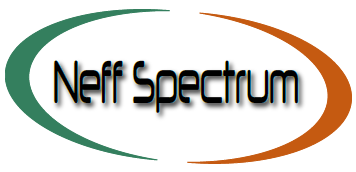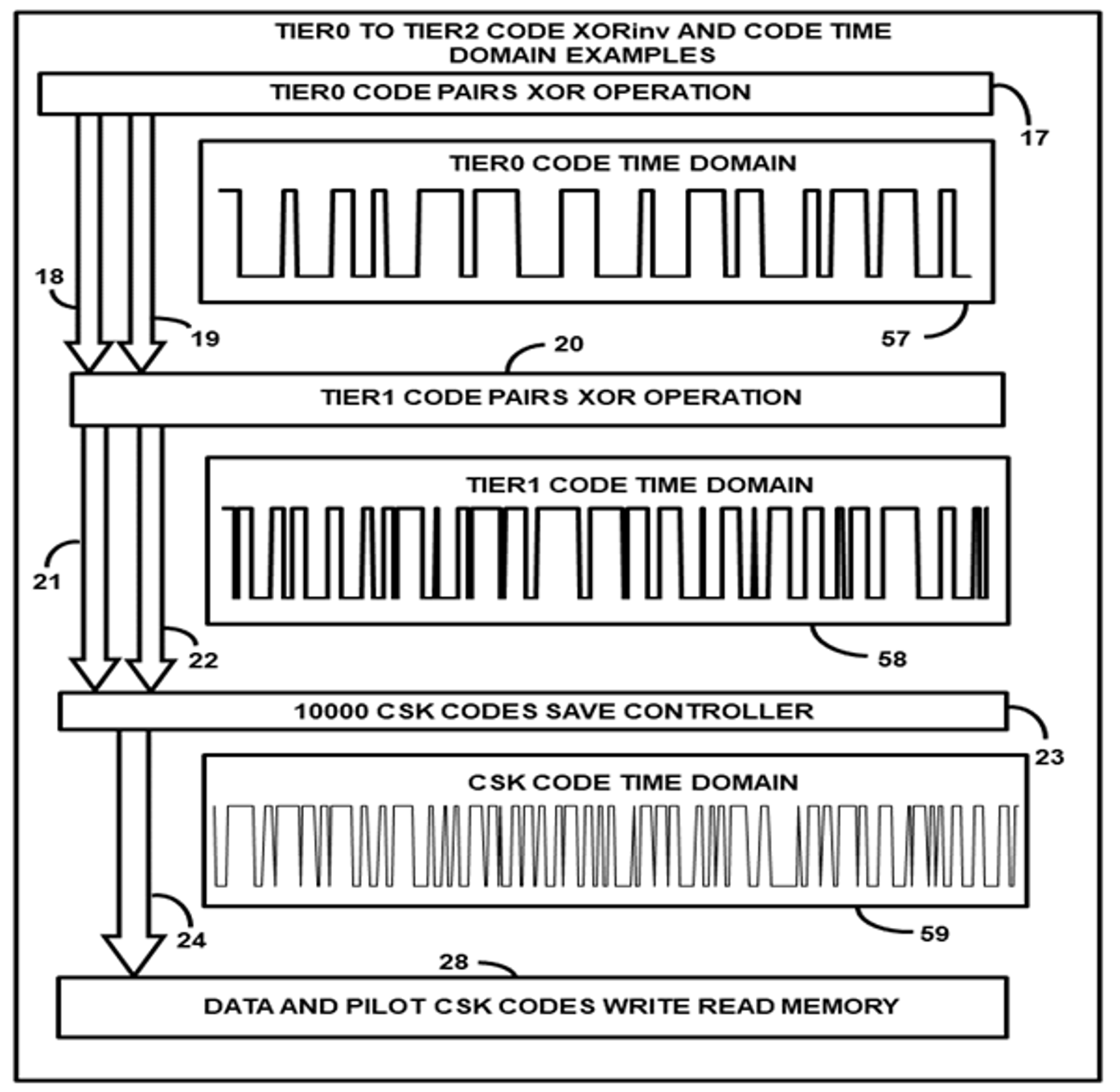

A new CSK random digital binary codes family has been defined that can replace shift register-based code families. Neff CSK Non-Cyclical Codes (Neff CSK) is designed to replace these families of codes with a patented code that outperforms PN codes by providing unlimited numbers of CSK non-cyclical, orthogonal sub- codes that can be used in every case where PN is now applied.
See the Neff Codes Patent
The Code Shift Key (CSK) random binary code generator of Patent No. US 10056937 B1 dated Aug. 21, 2018, is designed to produce large counts of orthogonal random binary codes, pre-filtered to minimum symbol cross-correlations, that are saved to memory for later live network modulator retrievals. Operational embodiments are for 1-second epoch synchronized 16-ary CSK symbol transmissions. Code lengths are consistent with a cluster of frequencies in a network channel discussed in papers 9 and 10 comprising 128 carriers around 3200 MHz as a sample network. The configuration of a Code Shift Key Generator defines a Tier0 binary code (top in figure), a Tier1 binary code (2nd in figure), and a Tier2 binary code (bottom in the figure) that is the CSK code of the source published patent.
A channel consists of a cluster of 1 or more carriers around a central carrier. The sample network CSK codes in these papers are to be saved in sets of 1-second epochs comprised of 250 frames where each frame is 4 milliseconds of transmit time. All CSK codes in these papers are described by code length, chipping rate, and System Denominator (number of CSK symbol lengths in 200 microsecond synchronization slot) usable with a resident precision universal time 5 KHz precision network clock pulse stream for each carrier transmit and for the associated delayed receive channel. The Tier0 Generator processes begin with a Fixed Count Pulse Width Distribution (FCPWD) of Tier0 Pulse Widths in bits. All Tier0 half-codes with indexed pulse widths are tandem-shuffled and remerged into full length random Tier0 binary codes. The pairs of Tier0 shuffled random binary codes are then XORed at binary bit level to create random Tier1 binary codes. The Tier1 codes are then XORed at binary bit level to create the Tier2, or CSK binary codes. These following technical background papers expand on sample network embodiment options to include bandwidth and throughput potential options centered on Tier0 Fixed Count Pulse Width Distributions.
The final Tier2 output CSK random binary code sample is shown at the bottom of the figure. Data transport is achieved by time-synchronous selections of CSK codes from memory and extraction of required code symbols by index 0 through 15 based on the transport 4 data bits. The CSK Symbol is selected from a circular-phase-shifted version of the source random CSK code retrieved from memory at network startup. The symbol transmission process receives a 4-bit half-byte word that points to a 16ary full length symbol, or optionally two 16ary half symbols transmitted in each 20- microsecond slot. The receive process is deterministic and synchronized to the resident 50 kHz receive universal time precision clock pulses based on the Universal Time pulse streams consistent with local Rubidium Standards for all transmissions.
In the half-symbol option 2 quadrature QPSK Symbols (half-CSK Codes) are detected in each 20-microsecond slot resulting in 4 parallel CSK Codes detected per 20 microseconds). This can create a data throughput of 4 * 4 bits per 20 microseconds or 2 Bytes of data per 20 microseconds (1 Byte per 10 Microseconds) throughput. There are 128 carrier channels transmitting in parallel providing giving 2 bytes * 128 parallel channels totaling 256 bytes per 20 microseconds (12.8 megabytes per carrier 100 MHz cluster total 2.048 Gigabits / second receive MIMO throughput.
The CSK codes with potential code lengths of 300 chips to 412 chips in the example network are presented in this series of papers. Although all CSK code lengths are possible, only CSK lengths divisible by 4 are used in this sample of a clusters of carriers for code symbol efficiency. Also, the examples of CSK codes used in papers 9 and 10 all have System Denominators of 10 with transmissions time-locked to Universal Time from a 512 time-keeping Declining Power Of 2 Distribution (DPof2D) CSK random binary code. Many code lengths are common to the selection of 128 carriers. It is assumed that Quadrature Phase Shift Key (QPSK) carrier modulation is used wherein 4 orthogonal CSK Symbols are detected in QPSK modulation in each of 128 carriers discussed in Technical Paper 9 and Technical Paper 10.
The options are now open to replace binary shift registers with more advanced forms of memory-based random binary codes that are pre-generated and pre-filtered for CSK Codes with minimum symbol cross-correlation parameters..
Neff CSK Codes are designed for efficient extraction of 16 orthogonal symbols defined as binary codes.
Patent No. US 10056937 B1 dated Aug. 21, 2018, describes the new technologies of CSK Codes of any length and any unique orthogonal code count by a code generator.
Patent No. US 10056937 B1 dated Aug. 21, 2018, invented random binary 16ary CSK Code generator technology. This technology makes possible infinite unique and orthogonal CSK code counts for any communications or navigation system.
The S-Curve cross-correlation synchronization technology has been used since the first PN digital voice transceiver of 1967. The current high GHz processing speeds and options for faster optical correlation makes this technology especially powerful as a best choice for .5 nanosecond synchronization accuracies.
This paper gives an example of a Neff CSK Code-based communications system to show Neff CSK Codes’ versatility and capacity.
A CSK modulation technique is a Direct-Sequence Spread Spectrum (DSSS) signaling method which overcomes the spreading gain versus data rate limitations of shift register-based codes.
With the CSK RANDOM binary codes of Patent No. US 10056937, navigation fix rate of 6+per second is possible.
Neff CSK generates RANDOM binary CSK codes that have a COMMON time of day reference independent of binary code length and chipping rate.
The CSK codes generated are random binary codes with the maximum count of unique orthogonal CSK codes proportional to the factorial of total pulse width counts in the CSK half code.
Every CSK Code Generator has a family of selected code lengths configurations with options for variable Pulse Width distributions that can be used to create multiple CSK 1-second epochs with equal code lengths.
The CSK Code Generator of Patent No. US 10056937 B1 dated Aug. 21, 2018, expands the shift-register codes to large network embodiment configurations containing unlimited numbers of orthogonal CSK Codes of lengths of 300 to 412 binary bits.
This paper presents the detail Power Spectral Density profile example verifying the general -10 dB bandwidth points estimated for the CSK Code. In the general CSK Code Null-to-Null is 2 * Chipping Rate.
Patent No. US 10056937 figure B1 defines 16ary CSK Code Generators for non-shift register binary codes designed for Memory Based access to 1-second epoch orthogonal CSK code sets for NEXT Generation of Digital Communication Networking and NEXT Generation of Terrestrial Navigation Systems with 6+ fixes per second and fix accuracy to less than 6 inches.
This paper shows the results of a specific analysis to verify Neff CSK provides a throughput value of 4+ GigaBPS.